First Time Boat Buyer Program: Essential Tips for Smooth Sailing
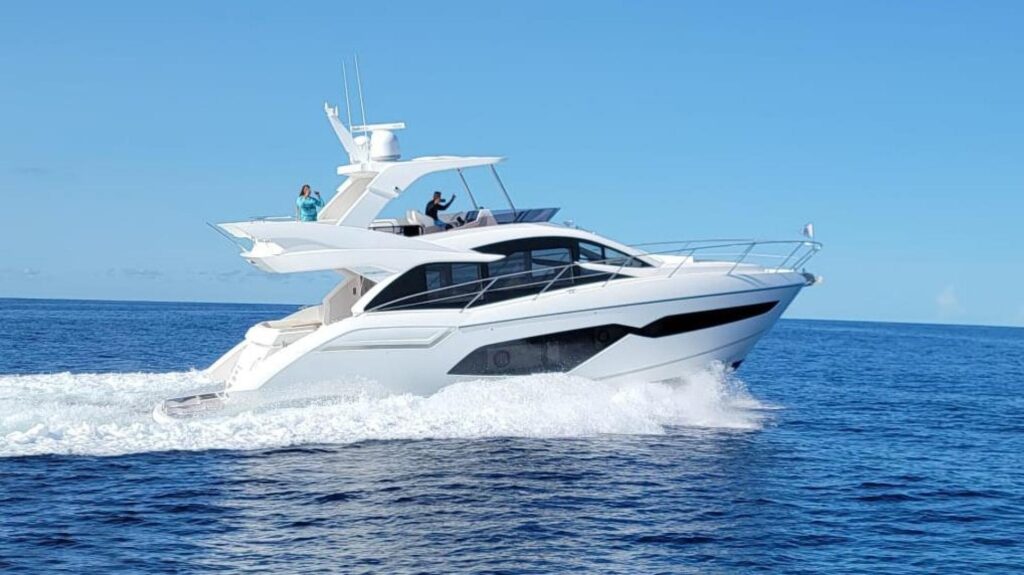

Last Updated on September 12, 2023.
Purchasing a boat is an exciting venture for many individuals, especially for first time boat buyer. As a significant investment, it’s crucial to have a clear understanding of the process and know what to expect throughout the journey. Embarking on this adventure can be overwhelming, but with the right resources, prospective buyers can make informed decisions and ultimately find the perfect boat to suit their needs and preferences.
A First Time Boat Buyer program can greatly assist newcomers in navigating through the complexities of boat purchasing. These programs often provide guidance on determining the right type of boat based on specific needs and interests, offer advice on financing options, and supply checklists to ensure a smooth purchasing process. By utilizing a First Time Boat Buyer program, individuals can avoid common pitfalls and be well-equipped to make educated choices, leading to a successful and enjoyable boating experience.
When considering buying your first boat, it is essential to understand different boat types and their primary uses. This section will discuss four popular boat types: Center Console, Cruisers, Day Boats, and Yachts.
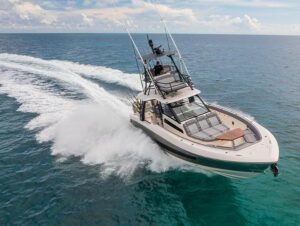
Center Console boats are popular among anglers who appreciate the “walk around” design, enabling easy access to all areas of the boat. Center consoles are also hugely popular with boaters that want to get somewhere fast and in style. They mostly run with outboard engines and can range from 15-60 feet or longer in some cases. Some popular models if you like to fish would be Boston Whaler, Intrepid, HCB, and if you would like to explore center consoles currently for sale, click here .
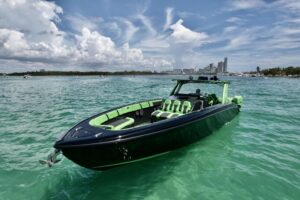
If you are more inclined to want to go fast and get somewhere in style, I would be looking at something more along the lines of a Midnight Express, MTI, NORTECH, or Statement Marine. For a list of available go-fast center consoles for sale, click here.
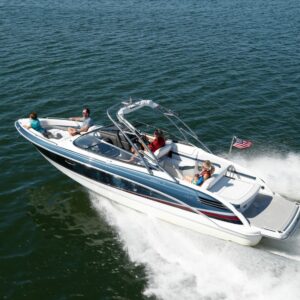
First Time Boat Buyer
A bow rider boat is a type of recreational motorboat characterized by its open bow area, which is located at the front (bow) of the boat. It is designed with a seating configuration that maximizes passenger capacity and comfort. Bow riders are popular for their versatility and are often used for various water activities such as cruising, watersports, and leisurely outings.
The distinguishing feature of a bow rider is the forward-facing seating in the bow area. This seating arrangement allows passengers to enjoy the open air and provides a great vantage point for admiring the surrounding scenery. Bow riders typically have a windshield or a low-level windscreen to protect passengers from wind and spray while underway.
Bow riders are designed with a spacious cockpit area behind the bow seating, which includes additional seating, a helm station for the driver, and often a small cabin or storage area. The cockpit area is where the driver operates the boat and controls the various systems and features.
Bow rider boats come in a range of sizes, from smaller models suitable for day trips to larger vessels capable of accommodating larger groups and overnight stays. They are typically powered by outboard motors or sterndrive engines, offering varying levels of speed and performance.
The versatility of bow rider boats makes them popular among families and recreational boaters. Their open layout, comfortable seating, and the ability to engage in watersports activities such as wakeboarding, tubing, and skiing make them a preferred choice for many boating enthusiasts.
Overall, a bow rider boat combines the pleasure of open-air cruising with ample seating capacity, making it an excellent choice for those who enjoy spending time on the water with family and friends. For a list of Bow Riders for sale, click here.
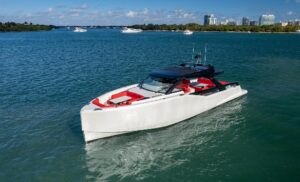
The current definition of “Dayboat” is probably the newest category in the list of boat types, and depending on where you boat, dayboat could mean something different to you.
From a South Floridian point of view, a dayboat is sleek and sexy, coupled with inboard or outboard engines, with lots of deck space and lots of open seating. Sizes typically range 40’ to 60’ in length.
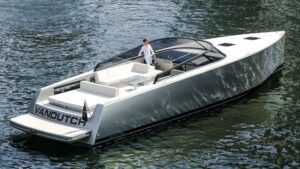
Performance and handling are important in the dayboat market, and a perfect dayboat will usually have Volvo IPS engines so the owner operator can easily maneuver the vessel with a Joystick and bow thruster, or Outboards preferably with a joystick and a bow thruster. The ideal dayboat is designed for recreational boaters in South Florida and how they use their boats 80% of the time. Cruising the ICW’s and dropping the anchor at one of the numerous sand bars or popular anchorages. Popular dayboat models include PARDO, Vanquish, VanDutch, HALO, Wajer, LIMITLESS, FJORD, & OKEAN. There are many other vessels classed as dayboats, however, these are the brands off the top of my head. Regarding price, depending on engines, equipment, and brand, the dayboat can range from just under a million dollars to in excess of 3 million dollars. Click here for a list of current dayboats for sale.
Yachts are luxury vessels, typically over 50 feet, designed for long-distance cruising or entertaining guests. They offer a comfortable and stylish experience, often including multiple cabins, a spacious salon, and state-of-the-art amenities. While yachts can be quite expensive, they cater to a specific audience who values the ultimate boating experience.
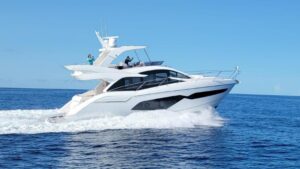
The list of yacht manufacturers has increased exponentially over the last ten years, there are so many boat builders from around the world, it’s almost impossible to keep up with. My favorite builders of traditional style motor yachts under 100’ at the moment are Sunseeker, Princess, Wajer, Sanlorenzo, and Pershing. I am partial to the Italian, British, and Dutch builders, however, there are many other amazing manufacturers building some incredible boats from all over the world.
In summary, understanding the various boat types extends to recognizing their specific uses and features. A first-time boat buyer should choose the boat type that best aligns with their preferences and intended activities on the water.
Before embarking on your journey to purchase a boat, it’s crucial to establish a realistic budget. Consider factors such as the cost of owning and maintaining a boat, including fuel, storage, maintenance, and repairs, in addition to the initial cost of the vessel plus any financing payments. If you would like an excel budget worksheet to calculate the total cost of owning your new boat, don’t hesitate to contact us at info@wavemarinegroup.com.
Deciding between a new or used boat can be challenging for first-time buyers. New boats offer the latest technology, design, and warranties, but can be more expensive and will have a steeper depreciation curve in the first couple of years.
On the other hand, used boats are more affordable, but may require extra maintenance or have outdated features. If you are considering a pre-owned boat, make sure you are working with an experienced team. There is absolutely nothing wrong with a pre-owned boat, and in some cases a one- or two-year-old boat can be even better than a new boat. Why is this? A new boat comes with what’s called a shakedown period, where in the first year of ownership if something is going to go wrong, it will go wrong in the first year. Don’t forget, boats are made by hand, and are subject to human error, so it’s completely normal in most cases to have to deal with a shakedown period. A very well maintained one year old boat for example, will have gone through this shakedown period and the current owner will have gotten the kinks out. The other benefit from buying a one-year-old boat is the original owner will have taken the brunt of the initial depreciation.
Boat shows are an invaluable source of information for first-time boat buyers, allowing you to explore the latest models, features, and technology. There is nothing better than having all your options lined up at the same time, in one convenient location. Attending boat shows also provides the opportunity to network with industry professionals and gather advice on boat purchasing and ownership.
Once you’ve found your ideal boat, make an offer that’s consistent with market value and your predetermined budget.
Don’t fall into the trap of working with a broker who sets your expectations too high when negotiating. For example, if you find a boat you like, and it’s listed for 1 million dollars, and your broker encourages you to make a super low offer and says something like, let’s make a 700k offer, you never know!! This type of strategy can sometimes set a false price ceiling in your mind. The facts are, statistically most boats sell for between 6% and 10% of list price. Of course, this is assuming that the asking price is reasonable, the vessel is in good condition, and we are in a stable but healthy market.
When making an offer, I like to offer below what I know will buy the boat, but not so low it’s insulting, and the seller won’t counter. A very good friend of mine once said. “A successful boat deal is when both parties are slightly upset… the seller feels like he sold for too cheap, and the buyer feels like he paid too much”.
The other important thing is to work with a broker who is experienced in the type of boat you are looking for. If you are searching for a luxury yacht, don’t hire a center console broker to represent you. You need a broker who is experienced in the sector you are looking for. There are a couple of reasons for this, first and foremost, they will know the inventory, the values, and know what has traded and for how much, secondly, they will know the players. They will be able to pick up the phone and talk shop with the corresponding broker, and most likely get more valuable information that will help in the negotiations.
When purchasing a used boat, it’s essential to arrange a thorough inspection and sea trial by a certified marine surveyor to identify any potential issues or repairs needed. Depending on the vessel, a dedicated engine survey may be required. Engine surveys are common on motor yachts with diesel engines.
A sea trial typically involves a test run of the boat with a technician or experienced boater to check the systems, engine performance, and general handling. The sea trial will also document the performance of the engine at different RPM’s in order to make sure the engines are performing to, or close to, manufacturer guidelines. During the sea trial, potential boat owners should familiarize themselves with the boat’s features and ask questions about its operation. This will help reduce the learning curve and make the transition to boat ownership smoother.
Some people have a misunderstanding of who pays for what during a survey. The rule of thumb goes something like this: The buyer pays for the surveyor, and the haul-out (if needed) and the seller pays for the captain and the fuel. The broker doesn’t pay for anything 😊
After all sea trials and surveys are complete, it is time to do one of three things.
If you have two willing parties, the usual cause of action is #3, unless something catastrophic happened on survey.
If you accept the vessel unconditionally, the deposit now goes “hard”, which means your deposit is now non-refundable. (Unless the seller fails to perform).
If you decide to reject the vessel within the given due diligence period outlined by the sales and purchase contract, all deposits are usually fully refundable, and the only money you are out of pocket is the survey related costs.
If you accept the vessel with conditions, it means that you are asking the seller to either give a cash credit (discount of the purchase price) or fix something prior to closing or within a reasonable period.
One common mistake made by inexperienced brokers is to try and use the survey to get un-justified amounts of money off the purchase price. The conversation goes something like this: I only want to pay 750k for the boat, but the seller is stuck at 800k. The broker then suggests offering the 800k and then asking for 50k as a survey concession after survey. Most sellers are savvy enough not to fall for this, and the end result is a failed transaction or you end up paying 800k for the boat anyway.
The best practice when making an offer is to follow these simple rules.
Another common mistake made by the buyer and seller is clearly defining what stays with the boat and what are personal item. Fenders, lines, safety gear, smart-Y power splitters, tenders, jet-skis, linen, cups, plates, electronics, and artwork are all examples of items I have seen cause chaos in the closing stages of a deal. The simple way to avoid any issues is to do make sure the purchase and sale agreement clearly defines what CONVEYS. Under the additional items section, list each item you would like to convey that could be questionable. Basically, if it can be easily removed it should be requested under additional terms.
It is not uncommon for larger vessels to be flagged offshore and these vessels could be subject to different rules and regulations when selling to US citizens, and in some cases, these vessels could have import duties that need to be paid. Always double check the tax and duty status before making an offer on vessels of this nature.
Marine lending is common; however, all conventional lenders are subject to pretty much the same guidelines. It doesn’t matter how well you know your mortgage broker, or your banker, once your application is submitted, you will be subjected to the same scrutiny as everyone else.
Some mortgage brokers will tell you something like this…… No problem, I’ll get you financed, I’m very creative. If you are going for a conventional loan, this is a major red flag. There isn’t a lot of creativity when it comes to marine lending guidelines.
Credit problems, income to debt ratio problems, or you show no personal income only business income are some of the issues that lenders can have issue with, and they may deny you. I once had a situation where a client got denied by a specific bank, and the mortgage broker proceeded to run his credit 6 more times with 6 different banks without permission.
The moral of the story is this: Make sure you have all your ducks in a row, you know your own credit score, and there are no surprises in store for you or the lender.
Lastly, it’s essential to obtain boat insurance to protect your investment. Insurance policies vary depending on the type and value of your boat, so research different providers and coverage options to ensure you have the right protection in place.
For first-time boat buyers, understanding the responsibilities of boat ownership is essential. Owning a boat requires regular maintenance, as well as securing proper insurance and registration. Also, consider the costs of fuel, mooring, and any necessary boating licenses.
Choosing the right engine and propeller setup for your boat depends on your intended use and budget. New boats typically offer the latest technology and lower maintenance costs, while used boats can often be more affordable. Consider factors such as fuel efficiency, horsepower, and noise levels when making your decision. For propulsion, options range from outboard motors to inboard engines, with varying levels of performance and efficiency. Click here to read our article on the major types of in-board engines.
Boat storage is an important consideration for any boat owner. Temporary storage options during the boating season may include marinas, docks, or mooring buoys. Winter storage may require transporting your boat to a secure indoor facility or shrink-wrapping it for outdoor storage. Be sure to plan for these costs and logistics in advance.
If you need to transport your boat on land, consider the towing requirements of your vehicle. The size and weight of your boat will determine the necessary towing capacity, as well as any additional equipment such as a trailer and hitch. Make sure your vehicle can safely tow your boat and that you are familiar with the legal requirements for towing in your area.
Lastly, consider where you will be using your boat most frequently. First-time buyers should factor in their preferred boating environments, such as fresh or saltwater, lakes, rivers, or oceans, when selecting a suitable boat. Additionally, proximity to boat ramps, marinas, and other boating facilities can impact your overall boating experience.
Once the boat has passed the sea trial, it is important to understand the warranty coverage. Warranties can differ depending on the manufacturer and type of boat, so it is crucial to read the warranty documentation carefully. It might cover the engine, accessories, or be limited to specific components. Regular maintenance is also essential to keep the boat in good condition and maintain its resale value. Creating a maintenance schedule, including routine inspections, engine servicing, and hull cleaning, will help ensure your boat lasts for years to come.
Finally, first-time boat buyers should consider joining a marina, or yacht club, to make the most of their boating experience. Marinas offer various services and amenities, including secure docking, boat storage, fueling facilities, and access to a community of fellow boaters. Many marinas also offer training programs and social events for members to learn more about boating and build friendships with fellow boat enthusiasts.
By following these steps after purchasing a boat, first-time boat buyers can ensure they are well-prepared for their new adventures on the water and build a strong foundation of knowledge for enjoyable and safe boating experiences.

Commodore of Deals & Keels at Wave Marine Group
Born and raised in the U.K. to a sailing enthusiast family, James has a lifelong connection to the water. He combined his passion for yachting with his expertise in technology, rising to Director of Information Technology at Lazzara Yacht Corporation. After achieving record sales at Sunseeker Florida, he later co-founded Wave Marine Group, a marine-tech company, with business partner Anthony Burns.